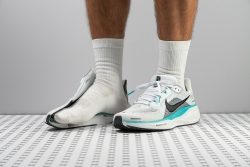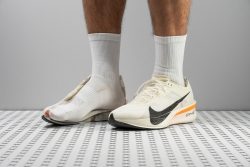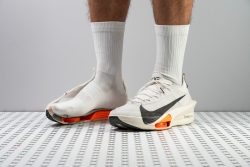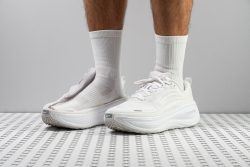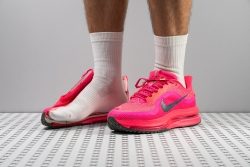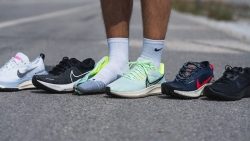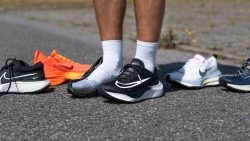7 Best Nike Running Shoes in 2025
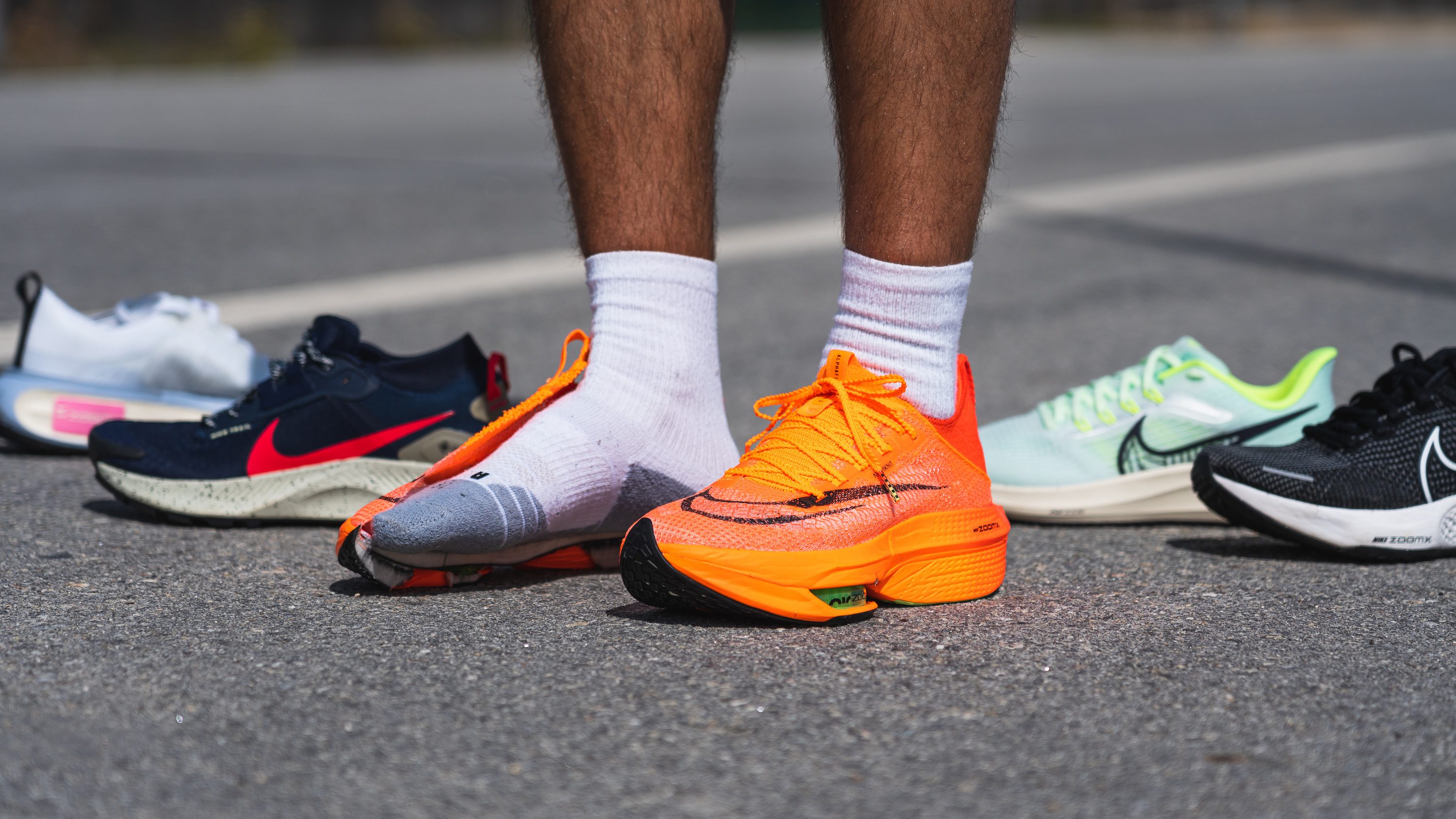
We buy shoes ourselves. We earn commissions when you buy through us, at no extra cost. Why trust us
Nike needs no introduction. The brand offers some of the widest selections of highly-rated running shoes for both beginners and seasoned runners. We are here to help you navigate this massive selection of Nike running footwear.
We have tested Nike running shoes on the test runs and in our lab to help you narrow down the choices. Here are our top picks in different categories.
And if you’d like to learn more about how to choose the ideal Nike shoe for you, scroll down to our in-depth guide!
How we test Nike running shoes
Nike is a serious brand. But we are even more serious here at RunRepeat. Equipped with our proprietary shoe testing methodology, we go beyond the vague marketing statements to find out which Nike shoe is truly the best. Here is what we take each shoe through:
- We purchase Nike shoes with our own funds to stay unbiased while testing every new release.
- We do test runs in each shoe to get a good feel for its comfort, fit, and performance.
- We cut, slice, and measure all Nike shoes in our lab, which results in more than 30 data points on their energy return, shock absorption, durability, breathability, flexibility, and others.
Best Nike running shoes overall
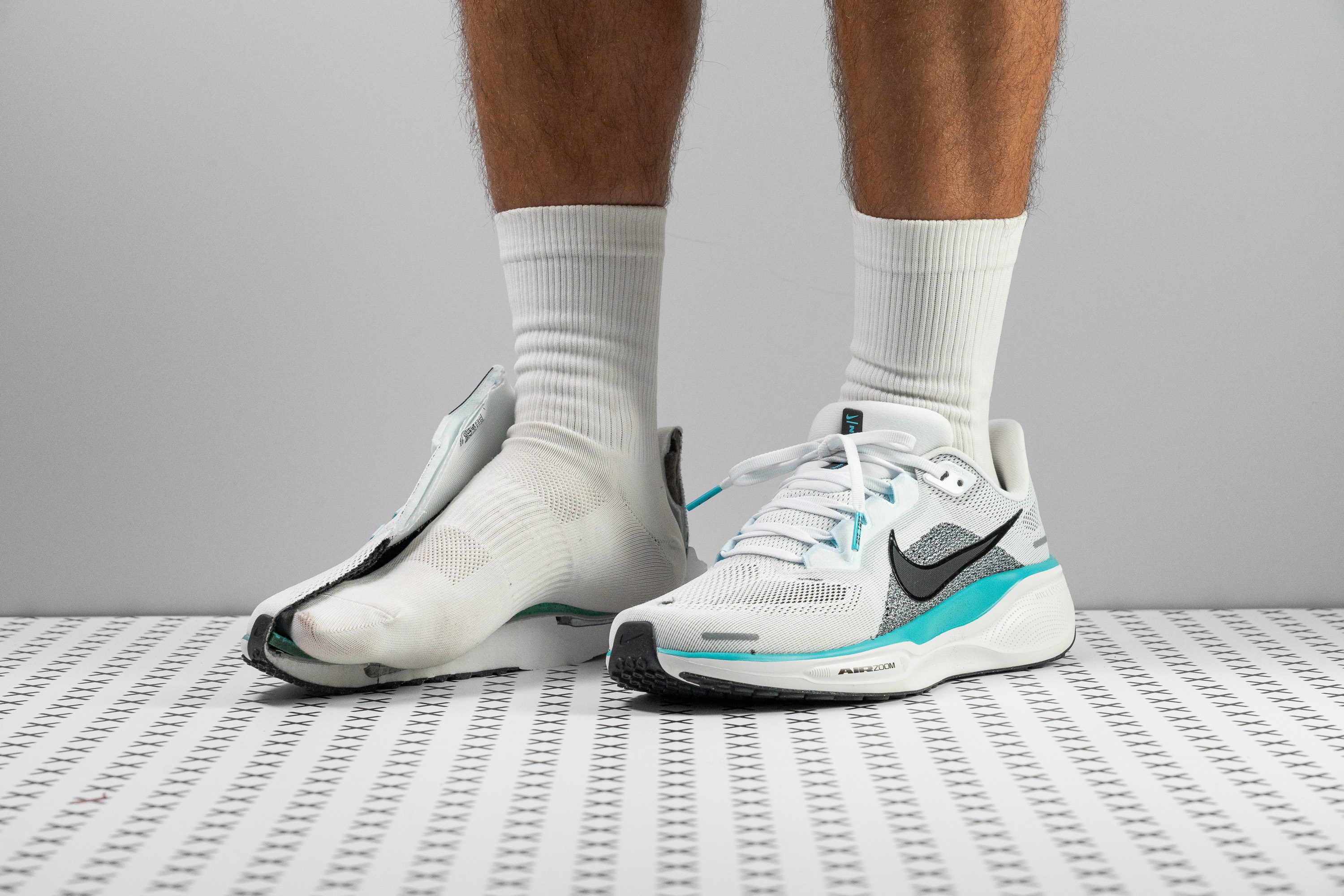

























































What makes it the best?
The Pegasus 41 has distinguished itself with solid performance both in actual testing and in the lab, solidifying its position as our top choice among Nike running shoes. Offering the ReactX foam and high versatility, it delivers exceptional comfort alongside a natural yet secure ride.
The Peg continues to be an absolute workhorse, effortlessly handling various paces and distances. It features the new ReactX foam and maintains the Air Zoom technology, which collectively hits the sweet spot between plushness and energy return. Our durometer confirms our assessment with a rating 26.2% softer than average.
The 41st version of the series also includes the most notable rocker design ever, paving the way for smoother transitions and springier toe-offs. Yet this trainer still retains its flexibility to promote foot strength and versatility. Our bend test confirms it’s 34.0% more adaptive than average.
The Pegasus 41 allows for an untamed ride at any speed by providing midsole sidewalls and midfoot guidance in the outsole for extra stability, without the stiffness. It also provides a vast landing base for any foot striker. Our caliper measures the forefoot and heel at 115.6/89.2 mm—a generous width to land safely.
However, the steep 11.4 mm heel drop makes this shoe less suitable for forefoot strikers. Those who prefer lower drops should explore elsewhere.
Pros
- Enhanced for heel strikers
- New ReactX foam!
- Improved breathability
- Plush upper
- Good durability
- Several stability enhancements
- Newly designed rocker and bevel
- Solid performance
- Superior lockdown
- Sustainable features
Cons
- Price increased by $10
- Worse than the v40 in cold temperatures
- Poor grip
Nike running shoes with the best energy return






















































What makes it the best?
After lab-testing and pounding the pavement with Nike’s top running shoes, we discovered the Vaporfly 4 as the king of energy return. This lightweight marvel holds boundless energy without discomfort. The miles roll by as Vaporfly 4 took us fast and far effortlessly in its airy package.
The ZoomX midsole feels alive with every stride, and our energy return test reveals massive scores of 78.1% in the heel and 74.5% in the forefoot. Our toe-offs feel smooth, and we’re able to maintain a good cadence thanks to the spoon-shaped Flyplate integrated in the midsole. This results in the stiffness needed to sustain our power and smash PBs. In our bend test, it emerged 18.4% stiffer than average, contributing to its snappiness.
Conquering a race is a tough feat, yet V4 makes it more enjoyable with its soft yet balanced platform. Its stack is at par with average, but feels more cushioned due to its high shock absorption level of 137 SA in the heel.
V4 feels incredibly light and pleasant on foot. At a mere 5.9 oz (166g), it sets a new standard for supershoes that average 7.3 oz (208g) in our roster. Adding to the airy feeling is the well-ventilated upper that avoids overheating, with a commendable 4/5 rating on our breathability test.
Such a high-performance shoe comes with a hefty price tag of $260. While it’s worth the investment, runners on a budget may try more affordable options.
Pros
- 13% lighter than the Vaporfly 3
- Awesome for 5K, 10K and 21K races
- Full ZoomX midsole
- Spring-loaded carbon-fiber Flyplate
- Fantastic lockdown with premium laces
- Moderate rocker for a more natural ride
- Improved perforated, removable insole
- Better rubber coverage in the forefoot
- Gets improvements from the Alphafly 3
- Great upper featuring breathability and durability
Cons
- Less ideal for marathon racing
- Still lacks the snappy feel of the Vaporfly 1&2
- Narrow midfoot and heel limit stability
Best Nike running shoes for marathon
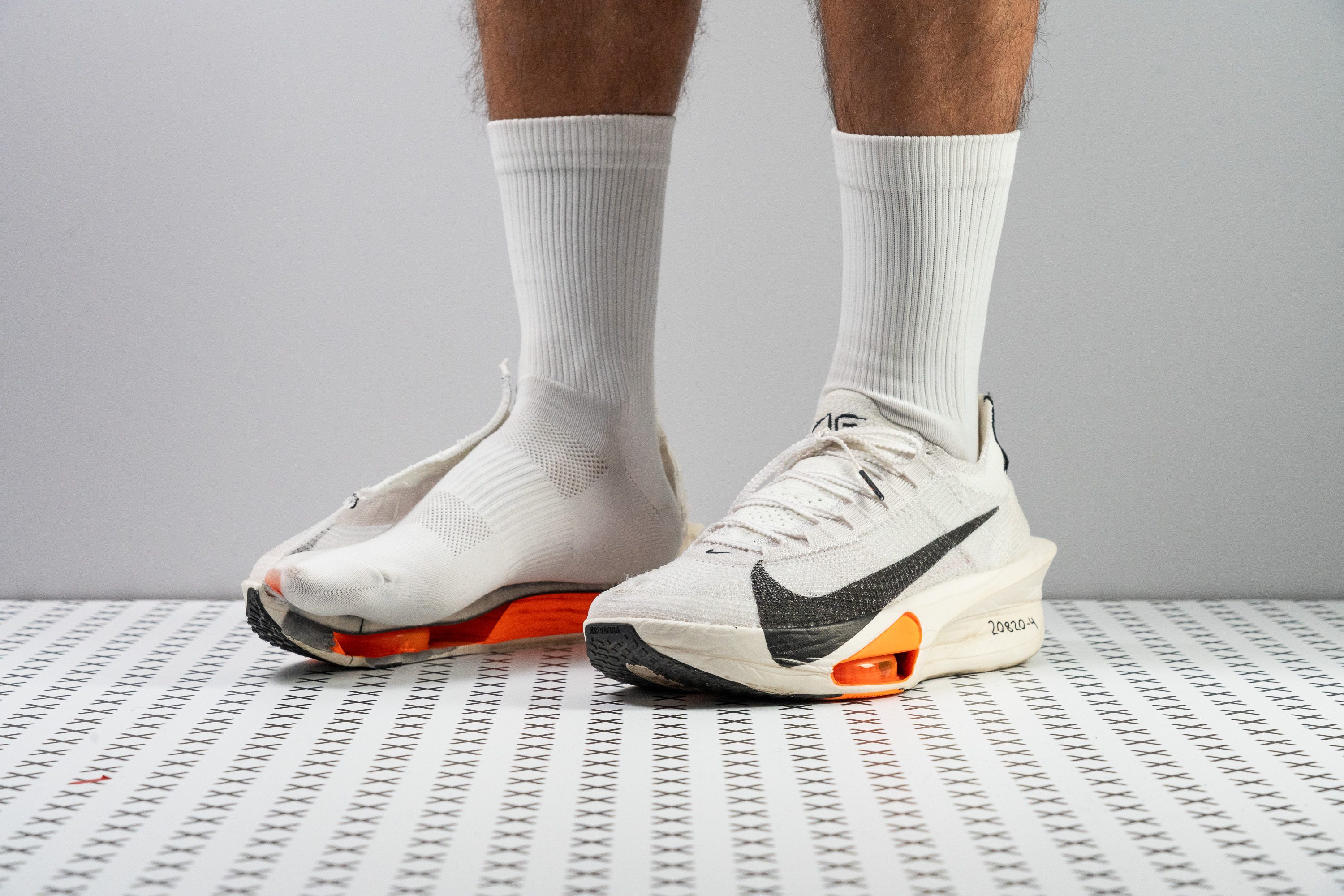









































































What makes it the best?
Alphafly 3 emerged as the best marathon/ultra shoe in our runs and lab tests. With unmatched energy, immense comfort, and revolutionary stability, this racer brought us to paces beyond our imagination. It shines in consistency, showing peak performance in longer miles.
We feel like we're flying as we launch forward with every stride. The stiff FlyPlate in the midsole maintains our strong pace from start to finish, while the Air Pods deliver the best energy return once engaged correctly. Proven by our bend test, Alphafly 3 boldly exceeds the average by 89.3%—perfect for smashing PBs.
Its world-class, leg-saving ZoomX foam has a cloud-like yet propulsive sensation, featuring dual-density foams for a balanced ride. The upper layer is a firm 29.3 HA for stability, while the second foam is a soft 18.1 HA for comfort. Further enhancing steady landings are the midsole sidewalls and broad landing base.
Alphafly 3 feels astonishingly light despite being max-cushioned. Our scales confirm its 7.1 oz (201g) weight is 6.1% lighter than the average race shoe. Adding to its airy feeling is the breezy Atomknit upper that scored the highest 5/5 on our breathability test. It guarantees exceptional airflow for hours of running.
Like most race shoes, the Fast Shot outsole prioritizes grip over durability. Heel-strikers should note this wears out faster in the rear area.
Pros
- Remarkably lightweight despite its broad size
- Best-in-class breathability
- Excels in the marathon distance
- Repositioned Air Pods offer a better ride than the v2
- ZoomX foam delivers massive energy return
- Aids in forward momentum, especially when legs begin to fatigue
- Better than ever for 5K/10K racing
- Finally smooth transitions!
Cons
- Heel strikers might wear down the outsole quickly
- The arch could still be a challenge for some
- The sock-like tongue might not suit everyone
Best Nike running shoes for 5K/10K races























































What makes it the best?
The Nike Streakfly 2 electrified our runs with its ZoomX midsole, offering the best performance for 5K/10K races among Nike running shoes. Besides its snappy nature, its ultralight build and extremely pliable midsole boosted our agility to the next level. There’s no slowing down in the Streakfly 2!
The ZoomX foam earned energy return scores way above average in our lab test. It’s able to return the force we exert by 76.3% in the heel and 77.9% in the forefoot, making a whole lot of difference compared to the 58.6% and 60.9% averages, respectively. It feels more natural to move at a faster pace in these shoes!
Its weightlessness sets a new standard in the lab, breaking records with its 4.5 oz (128g) build, 51.7% below average. In addition, its low resistance to bending makes us feel like we’re barefoot. In our flex test, it emerged as one of the most malleable shoes we’ve seen, needing only 7.0N to reach 30 degrees vs. the 15.2N average.
However, we’re concerned the outsole won’t last long since it has sections with exposed foam, and those covered with rubber surrendered easily to our Dremel. We recommend saving this pair on race day or using it in shorter training sessions or on less abrasive surfaces like a track.
Pros
- Feather-light build
- Ideal for 5K/10K races
- Wild, fun and fast
- Now features a carbon-fiber plate
- Much quicker than its predecessor
- Top-tier ZoomX foam
- Perfect for track workouts
- Not pricey all things considered
- Can stretch up to half marathon
- Grips well on dry and wet roads
Cons
- Not for heel strikers
- Only for short distances
- Narrow toebox
- Lacks stability
Nike road running shoes with the best stability
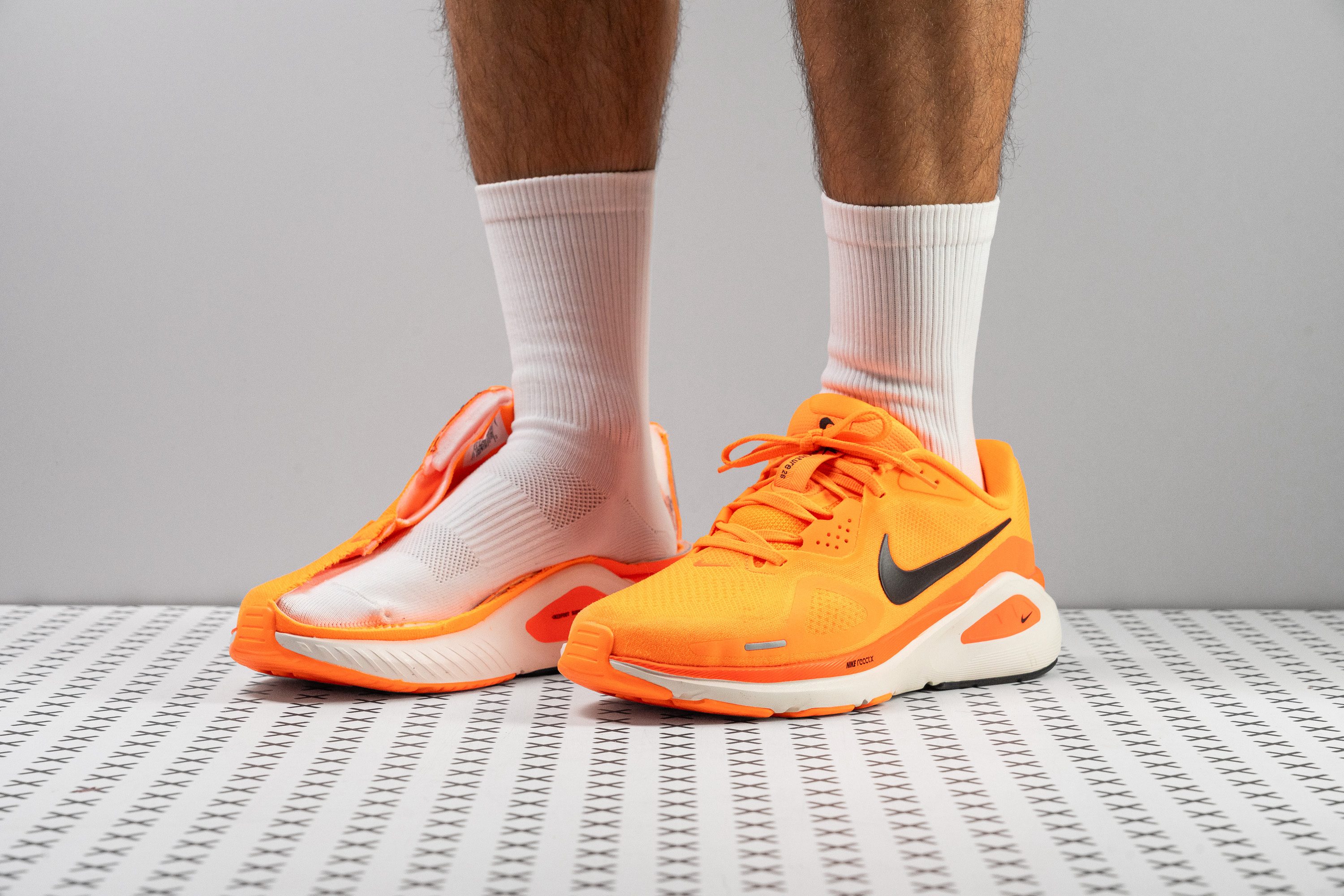













































What makes it the best?
Hours on the streets and in the lab make it clear that the Structure 26 is the top stability Nike running shoe. It offers a steady footing without losing comfort and versatility through its high level of impact protection and flexibility.
Structure 26 feels effortless on foot because we don’t have to put so much effort into keeping our strides stable. The shoe offers subtle support through the sidewall design that supports our arches, which prevents excessive lateral movements in the rear and midfoot area. In our manual assessment, the midsole resisted twisting firmly, so we awarded it a high 4/5 torsional rigidity.
In terms of bending our feet, the midsole offers minimal resistance. It emerged 8.0% more flexible than average in our 30-degree test, proving its comfort for daily wear and other activities.
When our runs went a little longer than planned, the ReactX foam offers impressive impact protection, particularly in the heel, with a strong 132 SA rating. However, we can’t say the same for the forefoot area, so Structure 26 is a better fit for rear strikers.
Pros
- ReactX foam upgrade
- Great choice for heel strikers
- Comfortable as a neutral daily trainer
- Outstanding durability
- Plush upper
- Solid stability in a compact build
- Versatile for everyday use
Cons
- Limited breathability
- Small price bump
- Not the best for forefoot strikers
- Reduced outsole coverage
Nike running shoes with the best shock absorption
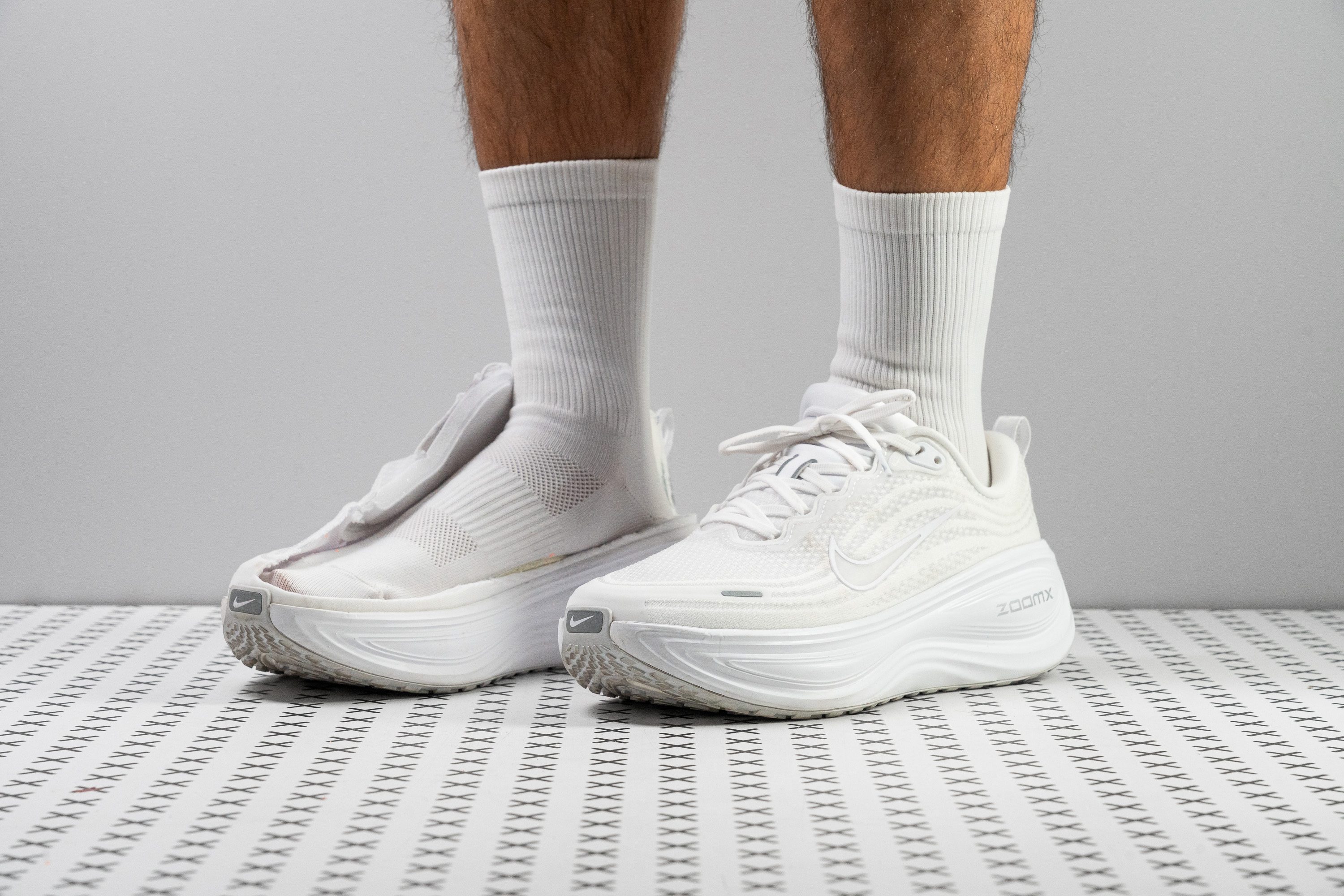












































What makes it the best?
The Nike Vomero Plus truly feels premium as it emerges at the top of the shock absorption arena among Nike running shoes. Its invincible combination of plush and maximum cushioning feels amazing on the foot. Adding to its magic is the stable and energetic ride. That’s a lot of “plus” features, but it’s still an understatement to what our lab showed and what our feet enjoyed.
A defining feature is the ZoomX midsole, known for its bouncy and protective nature, which boasts a maximum height of 42.3/32.7 mm. Boosting cloud-like support and dampening landing impact is its high shock absorption levels of 147 SA in the heel and 131 in the forefoot, offering above-average impact protection.
In terms of power output, we recorded impressive scores of 67.1% in the heel and 68.8% in the forefoot, explaining why the shoe never felt dull in our runs. It outperforms many trainers at this level.
Despite its plushness, we never lost our footing. We dissected the shoe and saw why: the midsole has tall sidewalls and a broad base to balance out Vomero Plus’ height and softness. We measured the base at 117.0/99.2 mm, securing our footing effectively.
Unfortunately, the toebox has limited room, which makes it less suitable for runners with plus-sized feet. We recommend those with additional room requirements in the front to explore other options.
Pros
- Full ZoomX midsole provides energetic bounce
- Outstanding shock absorption in both heel and forefoot
- True high-stack design
- Premium comfort from walking to long runs
- Strong durability
- Great pick for easy days
- Midsole resists cold very well
- Comfortable heel counter
- Solid Bondi alternative inside Nike
Cons
- Heavier than it should
- Snug fit and narrow toebox
- Non-gusseted tongue
- Traction still needs improvement
Best Nike supertrainer for daily running
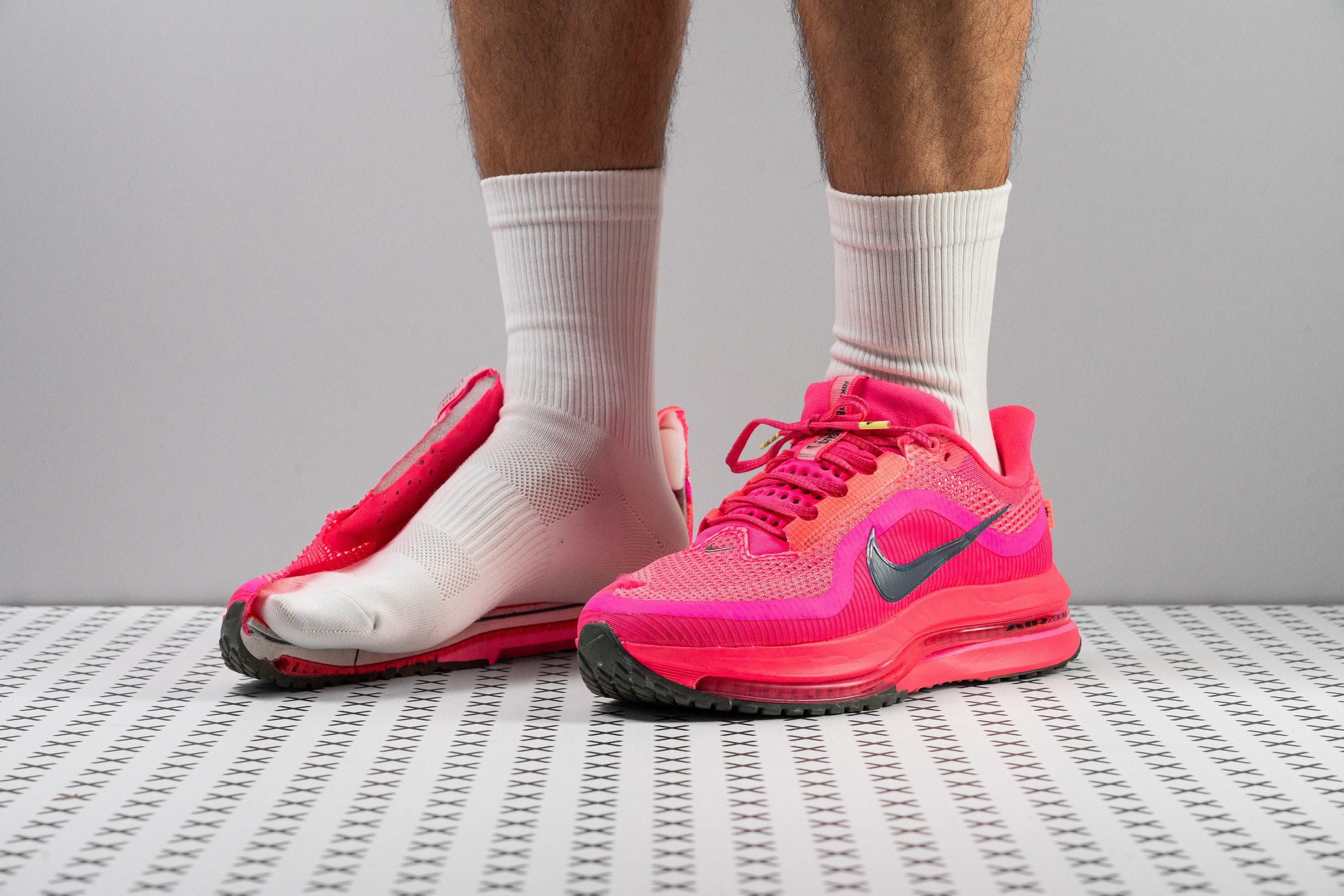




















































What makes it the best?
The Nike Pegasus Premium’s ride is as striking as its visuals! It delivers a highly energetic and ultra-bouncy ride through its triple-layer midsole, as we discovered under the knife in our lab. This explosive shoe is wrapped in a soft and breezy upper, with its mega stack making us forget the miles. Already in its name, it’s our top supertrainer among Nike running shoes.
Nike is pushing boundaries with this shoe, as seen in its 42.8/31.0 mm stack surpassing race-legal limits. It offers a virtually zero-ground feel for any footstrike and keeps the experience dynamic. The midsole includes a full-length Air Zoom unit, which helps reduce the impact of landings. Our shock absorption test reveals a high 155 SA rating, which makes it 21.1% more protective than average.
Speaking of the Air Zoom unit, it offers remarkable energy return and feels great underfoot from heel to toe. It’s spoon-shaped and acts as Pegasus Premium’s “carbon plate,” stiffening the ride for enhanced power and stability. True enough, it emerged 41.3% stiffer than the average running shoe.
The upper was pure bliss with its impressive combination of knit and mesh. It’s structured very well, offering both support and ventilation to our feet. The smoke instantly escaped the holes in our test, so we rated it with the maximum 5/5 breathability score.
Unfortunately, its narrow fit may limit its appeal and exclude wide-footed runners. Those seeking more internal real estate, whether for comfort or stability, should go for another pair.
Pros
- Triple-layer, spring-like midsole
- Handles long runs and tempo efforts
- Sublime step-in comfort
- Incredibly fun to ride
- Amazing build quality
- Knit upper offers top breathability
- Visually stunning from every angle
- 360-degree reflectivity
- Finally a max-cushioned Pegasus!
Cons
- Narrow fit excludes many runners
- Needs to lose some weight
- High price
- It's noisy!
Road or trail? Choose the right Nike running shoe
About 80% of Nike running shoes are meant for the road. So if you mostly run on pavement, asphalt, concrete, tarmac, treadmill, and the like, this is the type of shoe you need.
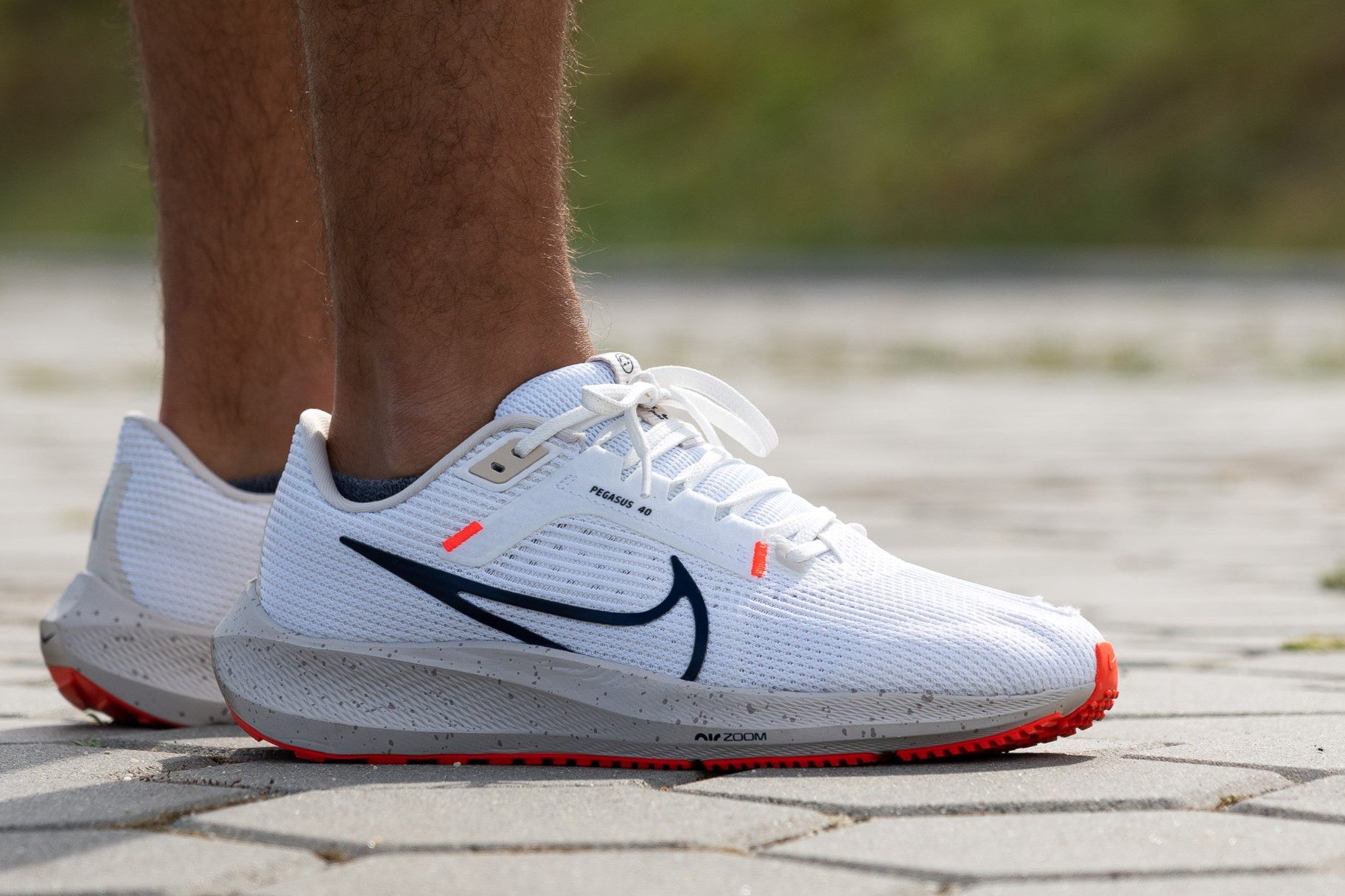
Trail shoes make up only 20% of the brand's running shoe stock. You will need these sturdier models for moderate and technical trails with rocks, roots, mud, and various debris. Nike trail shoes have deeper lugs and enhanced foot protection compared to road shoes.
It’s fine to wear your trail shoes on the road but only for a mile or two as the lugs will make prolonged wear uncomfortable or even painful.
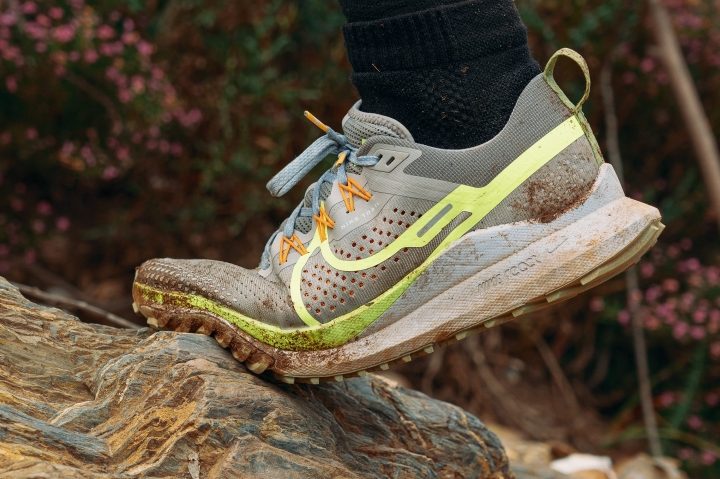
TIP: For road-to-trail use, choose Nike trail shoes with shallower lugs (3.5 mm or less). And if you frequent muddy and boggy areas, go for at least 4 mm of lug depth.
Nike shoes for daily running, tempo training, and breaking world records
What is the most essential factor in choosing an ideal running shoe? Setting your running goals clear.
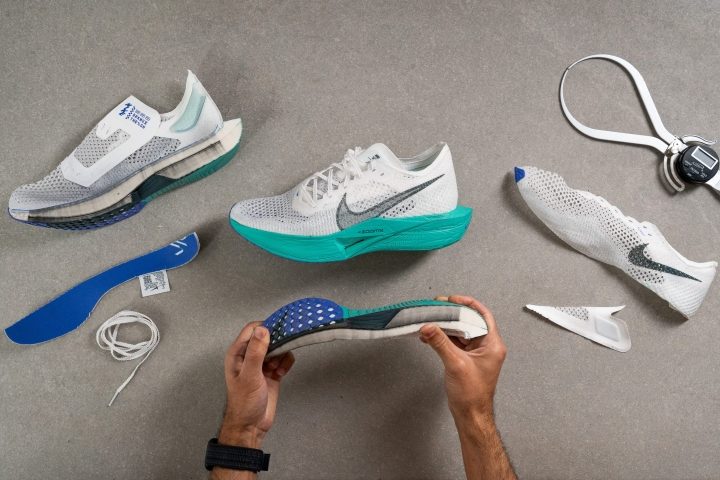
A Nike shoe that's meant for racing a 5K distance is going to feel very different from a cozy trainer for slow miles and walking.
Nike shoes for daily running and walking
This category of Nike shoes is perfect for most runners, especially beginners.
Here are the characteristics that make these shoes so favorable for many:
- moderate-to-high shock absorption
- well-cushioned (at least 30 mm of heel stack, 32 mm on average)
- moderate-to-high energy return
- average heel-to-toe drop (8-12 mm, ideal for a beginner’s heel-striking pattern)
- balanced softness (neither too firm nor mushy)
- no carbon plates or aggressive rockers
- average MSRP of $110
The only downside of these trainers is that they are the heaviest of the bunch. The average weight of a Nike shoe for daily training is 9.5 oz (269g) in a men's US size 9.
TIP: Shoes that weigh over 10 oz (283g) are better for slow paces, walking, and heavier runners.
Nike shoes for tempo training and competition
If you’re looking for a middle-ground daily trainer which can also go fast, Nike also has a selection of speed training shoes. Lighter, more nimble, and more responsive, these trainers are ready for tempo runs, intervals, and even shorter races (5K and 10K).
They tend to be lighter than daily running shoes (8.8 oz/249g vs. 9.5 oz/269g), have a higher heel stack (34.8 mm on average), and MUCH softer foams (76% softer based on our lab measurements!). Some of these trainers feature the brand's phenomenal ZoomX foam as well as a carbon plate. Running shoes for speedwork and racing have a higher energy return than daily trainers.
TIP: Choose a Nike shoe lighter than 8.8 (255g) if you plan to pick up the pace. Studies show that every extra 100g in a shoe slow you down by 1%.
Elite Nike shoes for competition and speed records
Ever since Eliud Kipchoge shattered the 2-hour marathon record wearing a Nike Vaporfly prototype in 2016, Nike changed the name of the game forever.
Featuring an extra high stack of foam with a propulsive carbon plate embedded into it, the Vapofly showed a nearly 4% improvement in running economy! What's more, the emerging popularity of shoes with similar technologies has led to breaking every men’s and women’s world record in long-distance road running events since 2017!
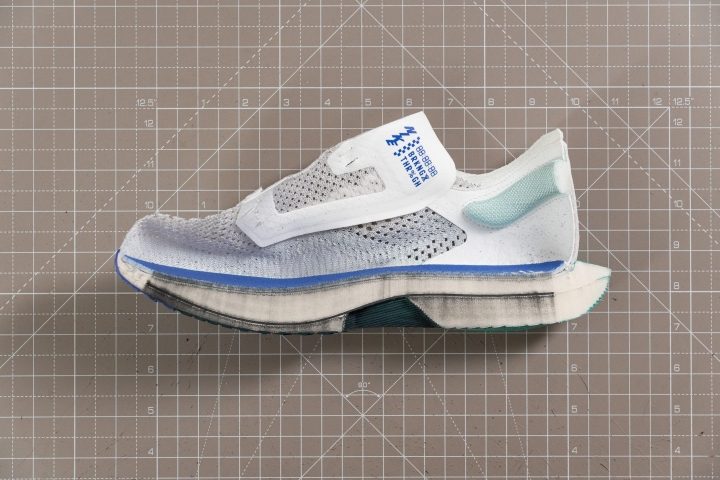
More than a few researchers stated that shoes akin to the Nike Vapofly and Alphafly provide an unfair advantage compared to regular running shoes.
In response, the World Athletics set certain regulations related to heel stack (no more than 40 mm) and carbon plates (no more than one) in competition shoes. The violation of these rules results in disqualification. However, neither Vapofly nor Aplafhy has ever been penalized by the organization.

Today, these are Nike's most expensive yet most sought-after race running shoes with the following characteristics:
- record-high energy return (74% and higher, based on our lab test results)
- an average weight of 7.3 oz (207g)
- a heel stack of around 37.5 mm
- extra soft ZoomX foams (40% softer than average)
- a full-length carbon plate
TIP: Read our comprehensive guide on carbon plates to learn more about their effect on running performance.
Choose the right cushioning in Nike running shoes
Want your future pair of Nike running shoes to feel like it was tailor-made for you? Make sure you get the following parameters right:
- stack height
- heel-to-toe drop
- shock absorption and midsole softness
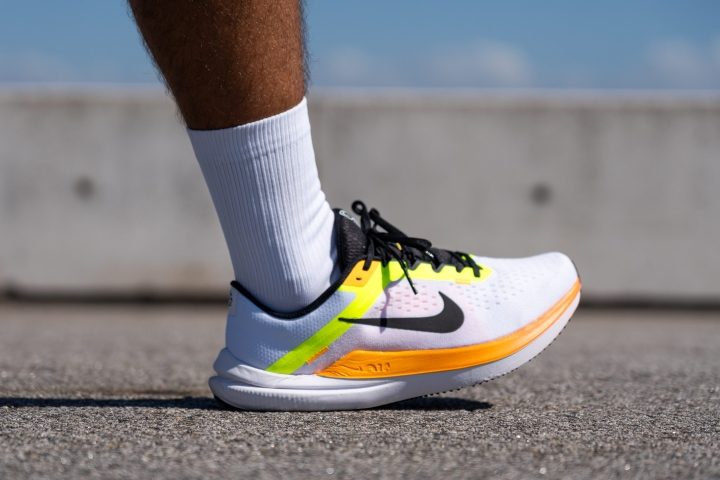
Stack height: max-cushioned or minimalist?
The average stack height of Nike running shoes these days hovers around 33 mm.
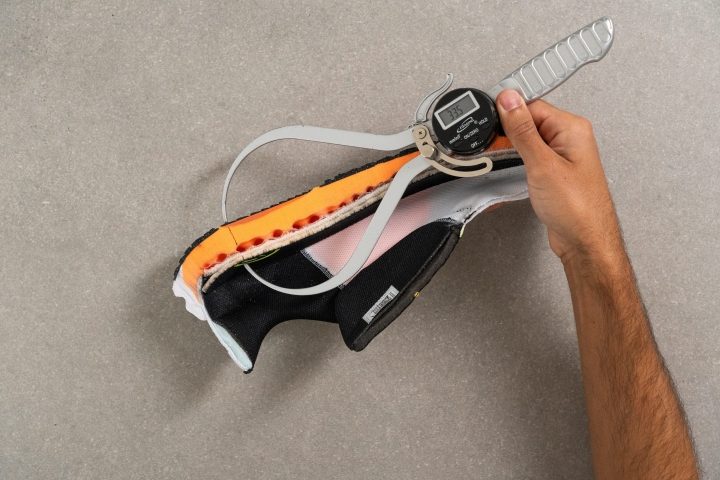
It means that a typical Nike shoe comes with a generous amount of midsole foam to protect your foot from hard landings.
But more cushioning doesn't necessarily imply better. Studies show that highly cushioned shoes are more likely to cause leg stiffness and injury, especially in beginner runners. So, if you are new to running, we recommend choosing a moderately cushioned Nike shoe with a heel stack of 30-34 mm.
Even though the era of minimalist running shoes peaked in 2012 and is now officially over, Nike still offers a few options for the fans of the ground feel. These include shoes from the Nike Free and Nike Flex series.
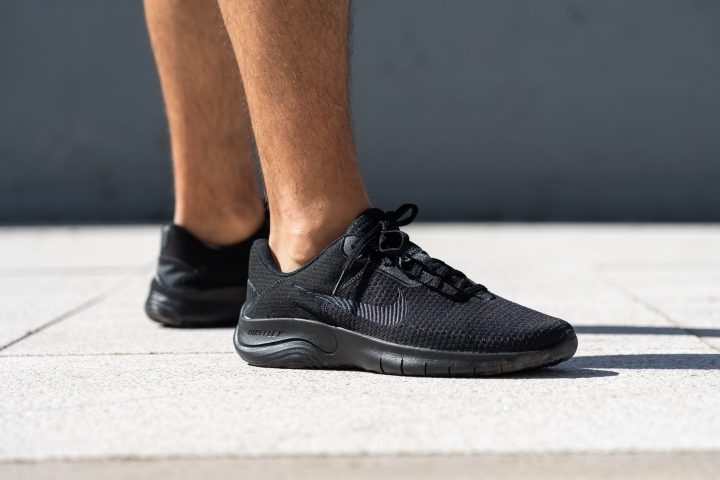
These shoes are incredibly lightweight (7.5 oz/212g on average), flexible, and feel almost like being barefoot. But as a beginner, you must be aware of the adjustment period that comes with this type of footwear.
Because of the different biomechanics involved in these shoes, we highly advise taking it slow with minimalist shoes if you've never worn them before.
Heel-to-toe drop: mind your strike pattern
Drop refers to the difference in thickness between the shoe's heel and the forefoot. It lets you know how steep is the slope inside the shoe.
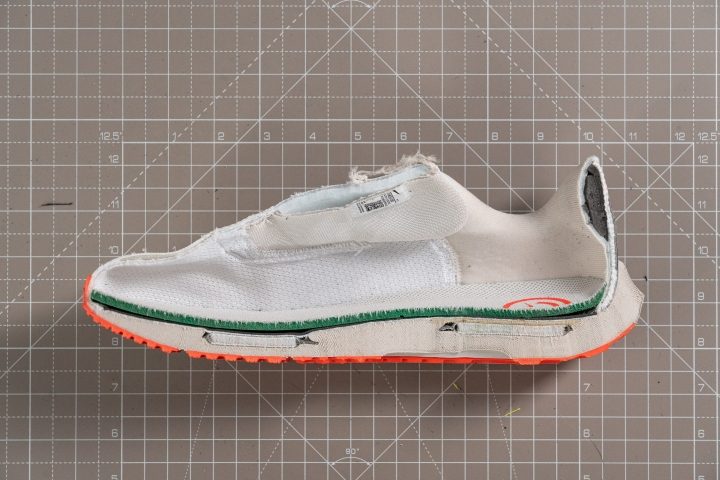
The average heel-to-toe drop in Nike running shoes comes in at 9-10 mm, which is ideal for most runners and beginners as well. When in doubt, just go for a drop between 8 and 12 mm.
But why are there Nike running shoes with a lower drop?
A heel drop below 8 mm is more suitable for runners with a forefoot/midfoot striking pattern. That's why you will find it in the brand's tempo trainers and minimalist shoes.
You can find out more about the effect of drop on running performance in our extensive research.
Shock absorption and midsole softness in Nike running shoes
Having tested hundreds of shoes in our lab, we can confidently state that Nike running shoes are about 15% softer than average.
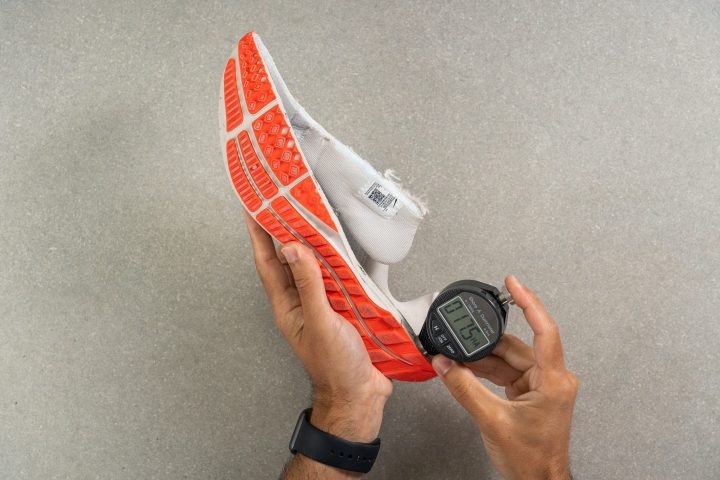
Getting a Nike shoe nearly always equates to a plush underfoot experience from the first step down to the last mile of your run.
However, overly plush cushioning can do more harm than good to:
- beginner athletes who have not developed proper foot and ankle strength yet
- runners with flat feet and overpronation who need more support
- heavier runners whose shoes tend to bottom out quickly
We believe that most runners will benefit from a balanced type of cushioning within the range of 15-25 HA durometer measurement. But, the softness is only a smaller part of the story. We prefer focusing on shock absorption, which tells us how good the shoe is at dampening the impact at the landing. The higher the shock absorption, the less stress is sent towards our muscles, tendons, joints.
A lower HA number indicates softer foam and vice versa.
Seasoned athletes in search of plush foam for recovery runs, marathons, or even ultras will benefit greatly from Nike's famous ZoomX cushioning. Used in the brand's elite speed trainers and competition shoes, it is not only soft but also has some of the best energy return properties on the market. Its advantages over standard EVA foam have been confirmed in multiple studies.
We consider shock absorption high when it scores above 130 SA. Anything above 110 SA is medium shock absorption, which is solid for many daily trainers and occasional/beginner runners.
Energy return of Nike running shoes
Ever since the 4% story, talking about Nike running shoes, especially the race ones, hasn't been possible without focusing on energy return. In our lab, we test energy return following the ASTM F1976 13 standard. We use it to test shock absorption and energy return at the same time.
The result is given in % and tells us how efficiently the foam rebounds after the landing. Some foams bottom out immediately or prematurely, which leads to premature leg fatigue, as the legs have to work more. When foams are (highly) responsive, they make runners "work less," which is why premium foams are said to have leg-saving features.
| Average energy return at the forefoot comparison | ||
| Nike | All brands | |
| Daily trainers | 57.2% | 56.7% |
| Tempo shoes | 72.9% | 67.0% |
| Race shoes | 74.8% | 73.4% |
We consider anything above 65% to be a great energy return. Of course, the higher the better.
Do Nike running shoes have arch support?
Unlike New Balance, ASICS, and Brooks who announce their stability shoes loud and clear, Nike hasn't put such a big emphasis on supportive footwear.
99% of Nike's running shoe selection is targeted at people with neutral pronation. So, if you happen to have flat feet or excessive inward rolling of the ankles (aka overpronation), Nike is not your best bet. If you are not sure about your case, have a look at our comprehensive guide on pronation.
Our lateral stability tests show too much wiggle in Nike running shoes
For those who need just a touch of support, we have put together a selection of Nike shoes which a bit stiffer and wider platform to help mild overpronation.
Shoes with a higher score for torsional rigidity and heel counter stiffness (5 is the stiffest) and wider platforms provide better stability and support.
There is some good news too. In 2023, the brand revived its Structure series by releasing a 25th edition after a few years of pause. It is specifically designed as a stability shoe.
Make sure you get the right size and fit
In most cases, we found that Nike running shoes run true to size compared to other popular athletic brands. But we always strongly recommend consulting the brand's size chart before ordering a Nike shoe online.
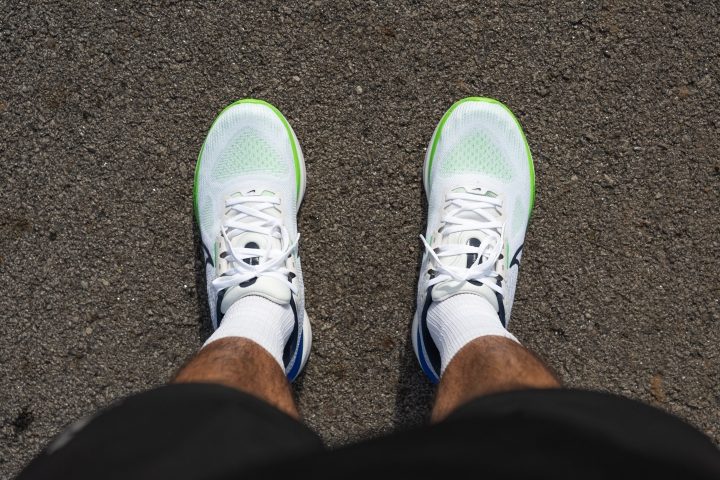
Ideally, we also advise taking precise measurements of your foot length before getting a new pair of shoes. You might be surprised to find that your feet have grown!
When it comes to the width of the shoe, we pour our special gel into the shoe and then freeze it with the shoe.
Once it's hard enough, we take it out and measure the width of the shoe in 2 places: at the big toe and where it's the widest. We do this to see if the toebox tapering is aggressive or not and to better understand the overall fit
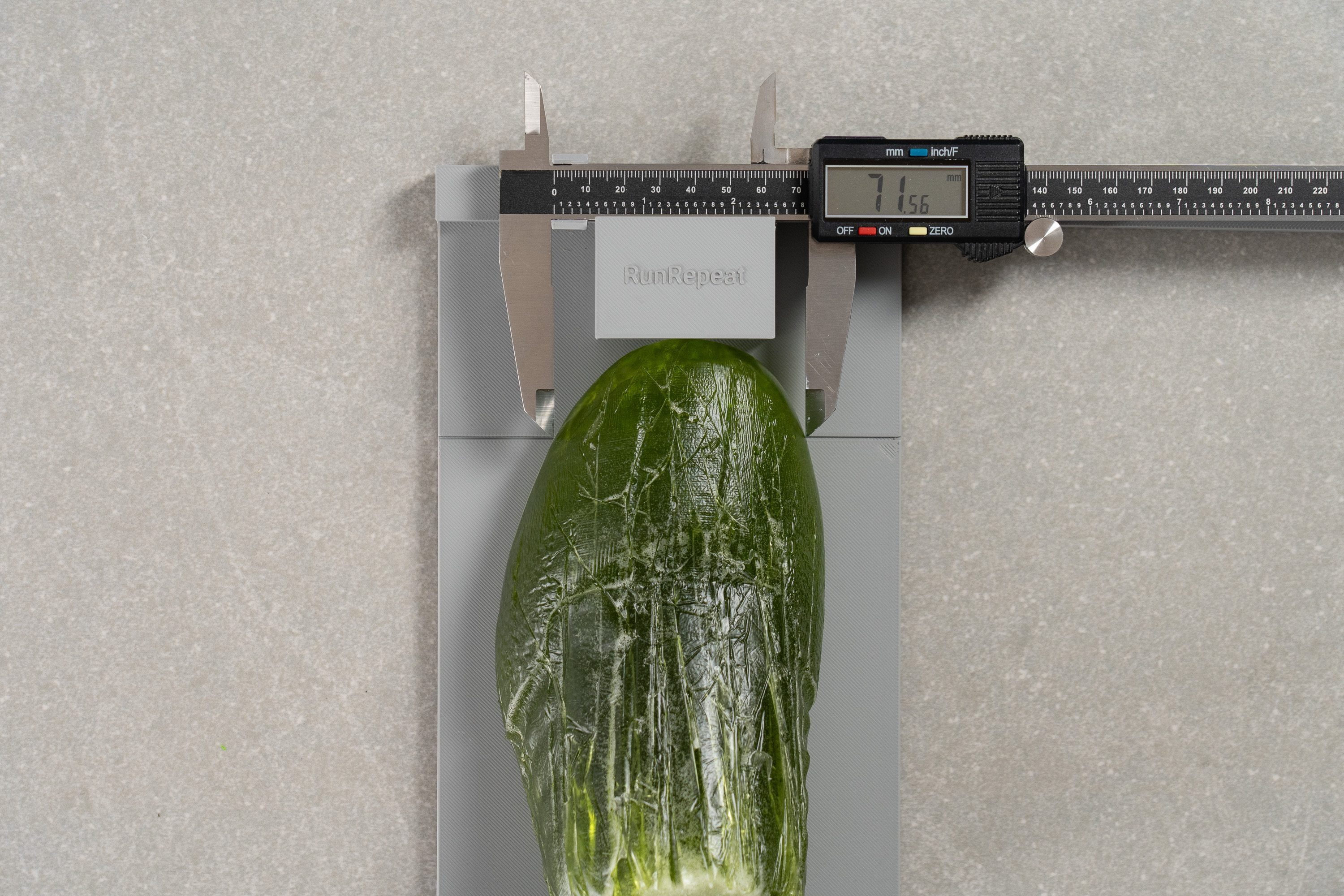

Depending on the shape of your toes and feet, you may need more room closer to the tip of the shoe (at the big toe), or where the shoe is the widest.
We also use this gel mold to measure the height of the toebox in Nike running shoes. We just have to cut it in half to be able to do this.
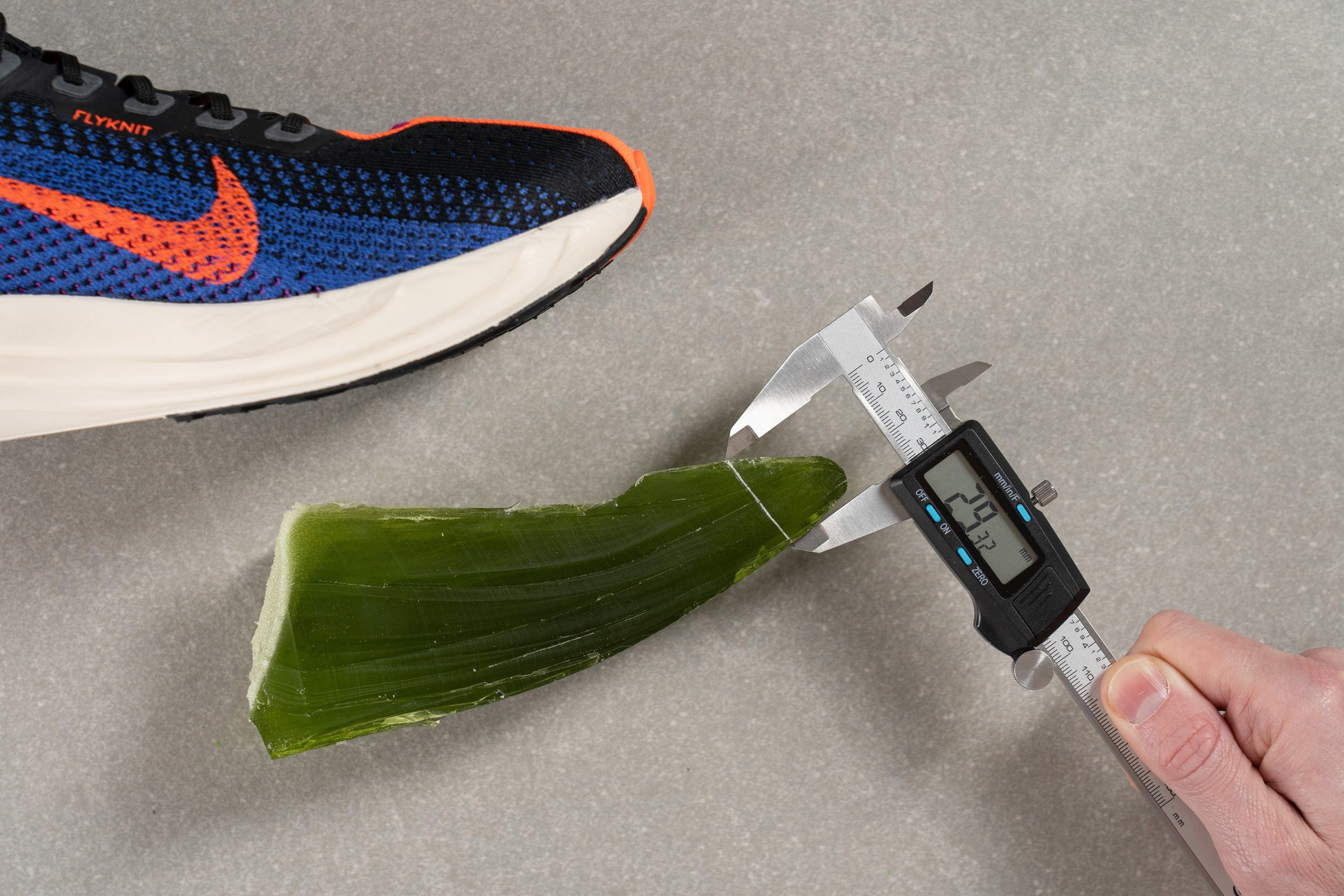
While race shoes tend to be more aggressive, sometimes even daily trainers have a low toebox, which may press on your toes and toenails too hard. If you've already experienced this, we recommend looking for Nike running shoes with high toeboxes.
Summer or winter? There is a Nike shoe for both
In our lab, we perform a thorough breathability check on each Nike running shoe.
We start by filling the shoe's upper with smoke and observe how well it passes through the fabric.
This test is followed by a transparency check against the light and a more detailed look at the material through our microscope.
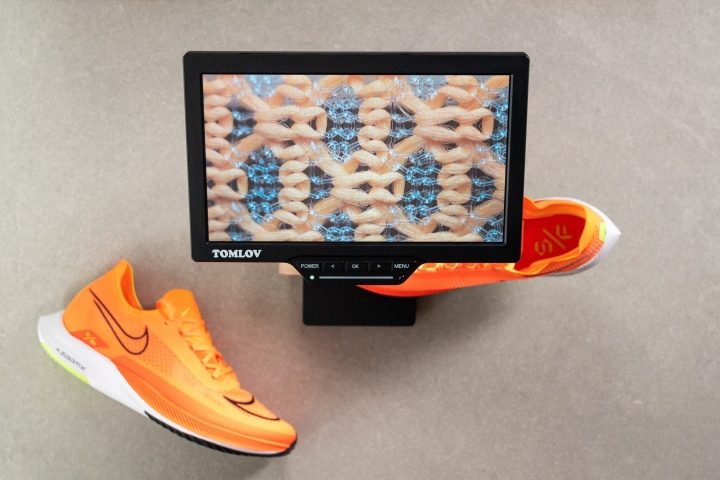
All tests considered, we give each Nike shoe a final breathability score from 1 to 5, where 5 stands for most breathable. For hot summer runs, go for shoes with a score of at least 4.
And if you set out to conquer winter runs, you will need a warmer, less breathable shoe (score: 1-2). Waterproofing is only necessary if you regularly run in rainy weather, deep puddles, or snow/slush.
How to know if a Nike running shoe is waterproof? Road shoes will have the word "Shield" in their name. It is the brand's proprietary water-resistant treatment. Trail shoes will have the "GTX" abbreviation or "GORE-TEX" added to their names. This is the world's most famous waterproofing membrane.
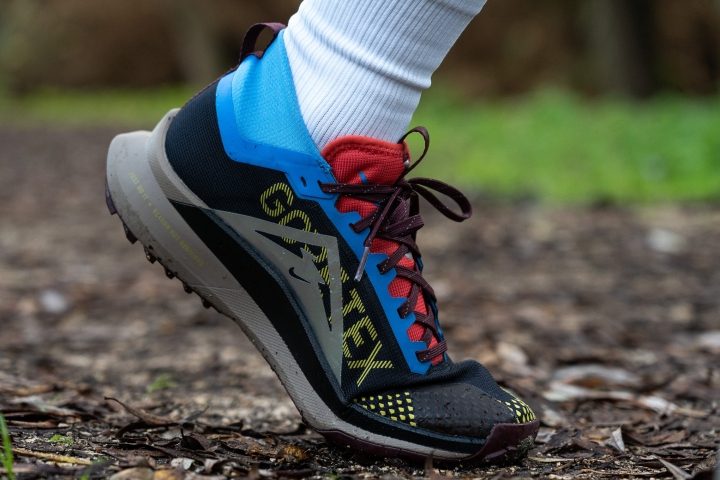
Traction in Nike running shoes
Even before testing the shoe for traction, we look at the outsole design. How much of its surface is covered in rubber? Are there midsole areas that have been carved out to reduce weight and maybe improve flexibility? Is there a lot of exposed foam in contact with the ground? And other details that we always thoroughly discuss.
But, as with any other lab test that we do, the traction test is also standardized, which means each running shoe is treated the same. We actually follow SATRA TM144 testing methodology and test the traction in wet conditions. The result is a dynamic coefficient of friction and the higher it is, the better! Ideally, shoes should have a 0.45 or higher CoF to play it safe in wet weather. However, traction above 0.25 is solid for dry surfaces.
Additional features in Nike running shoes
As a nice bonus, some Nike running shoes offer extra features for added convenience.
Nike FlyEase
Without the fuss of laces, Nike's proprietary FlyEase design allows you to simply slide your foot in and out of the shoe in an instant. No need to kneel or use both hands.
How it works on the Nike Revolution 5 FlyEase
Reflective elements
Some Nike running shoes also feature reflective elements to give additional visibility in low-light running conditions.

